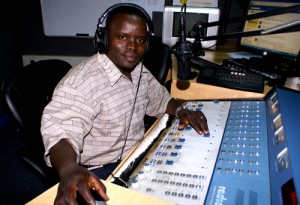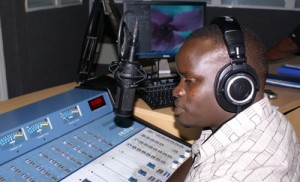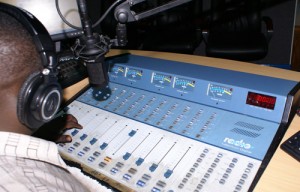 Well, R4D got a bit of a shock to see the Youtube clip about Joshua Arap Sang (Sept. 26 post) receiving over 8,000 views overnight.
Well, R4D got a bit of a shock to see the Youtube clip about Joshua Arap Sang (Sept. 26 post) receiving over 8,000 views overnight.
No doubt in response to the International Criminal Court allegations that Sang, along with William Samoei Ruto and Henry Kiprono Kosgey, bears;
“Criminal responsibility under Article 25 of the Rome Statute for murder, torture, deportation or forcible transfer, and persecution based on political affiliation as crimes against humanity.”
It’s hard to reconcile the guy in the video with the crimes he’s supposed to have committed. My first reaction was – where is the evidence? As Julius Lamaon, the CEO of Kass said (Nov. 2 post) where is the “scientific data”?
I’m not for a second discounting the seriousness of the allegations – “hate radio” is of course a very dangerous thing – and it will be good to have the issue given public discussion via the impending Hague trial. It will be very interesting to see what eventuates. Click “View Full Article” below to see sections taken from the official charges relating to Sang;
(For the full article visit; Mashada)
A. SUMMARY OF THE CASE JOSHUA ARAP SANG (“SANG”), a prominent ODM supporter, was a crucial part of the plan, using his radio program to collect supporters and provide signals to members of the plan on when and where to attack. To reach their goal, RUTO, KOSGEY and SANG coordinated a series of actors and institutions to establish a network, using it to implement an organizational policy to commit crimes. Their two goals were:
(1) to gain power in the Rift Valley Province, Kenya (“Rift Valley”), and ultimately in the Republic of Kenya, and
(2) to punish and expel from the Rift Valley those perceived to support the PNU (collectively referred to as “PNU supporters”).
2. Kenyans voted in the presidential election on 27 December 2007. On 30 December 2007, the Electoral Commission of Kenya declared that Mwai Kibaki, presidential candidate for the PNU, had won the election. The announcement triggered one of the most violent periods in Kenya’s history. The Prosecution will present some of the incidents, identifying those who are most responsible.
3. Thousands of members of the network (“perpetrators”) cultivated by RUTO, KOSGEY and SANG began to execute their plan by attacking PNU supporters immediately after the announcement of the presidential election results on 30 December 2007. On 30?31 December 2007, they began attacks in target locations including Turbo town, the greater Eldoret area (Huruma, Kimumu, Langas, and Yamumbi), Kapsabet town, and Nandi Hills town. They approached each location from all directions, burning down PNU supporters’ homes and businesses, killing civilians, and systematically driving them from their homes. On 1 January 2008, the church located on the Kiambaa farm cooperative was attacked and burned with more than one hundred people inside. At least 17 people died. The brunt of the attacks continued into the first week of January 2008.
4. All identified attacks occurred in a uniform fashion. Perpetrators gathered at designated meeting points outside of locations selected for attack. There, they met coordinators, who organized the perpetrators into groups with assigned tasks. Perpetrators then attacked target locations. Some perpetrators approached on foot, while others were driven in trucks, as had been previously arranged. SANG helped coordinate the attacks using coded language disseminated through radio broadcasts.
5. In response to RUTO, KOSGEY and SANG’s planned attacks on PNU supporters, as well as to deal with protests organized by the ODM, prominent PNU members and/or Government of Kenya officials FRANCIS KIRIMI MUTHAURA (“MUTHAURA”), UHURU MUIGAI KENYATTA (“KENYATTA”), and MOHAMMED HUSSEIN ALI (“ALI”) developed and executed a plan to attack perceived ODM supporters in order to keep the PNU in power.
6. First, under the authority of the National Security Advisory Committee, of which MUTHAURA and ALI were Chairman and a member, respectively, the Kenya Police, in joint operations with the Administration Police (“Kenyan Police Forces”), were deployed into ODM strongholds where they used excessive force against civilian protesters in Kisumu (Kisumu District, Nyanza Province) and in Kibera (Kibera Division, Nairobi Province). As a consequence, between the end of December 2007 and the middle of January 2008, the Kenyan Police Forces indiscriminately shot at and killed more than a hundred ODM supporters in Kisumu and Kibera.
7. Second, MUTHAURA, KENYATTA and ALI also developed a different tactic to retaliate against the attacks on PNU supporters. On or about 3 January 2008, KENYATTA, as the focal point between the PNU and the Mungiki criminal organization, facilitated a meeting with MUTHAURA, a senior Government of Kenya official, and Mungiki leaders to organize retaliatory attacks against civilian supporters of the ODM. Thereafter, MUTHAURA, in his capacity as Chairman of the National Security Advisory Committee, telephoned ALI, his subordinate as head of the Kenya Police, and instructed ALI not to interfere with the movement of pro PNU youth, including the Mungiki. KENYATTA additionally instructed the Mungiki leaders to attend a second meeting on the same day to finalize logistical and financial arrangements for the retaliatory attacks.
8. As a consequence, the Mungiki and pro?PNU youth attacked ODM civilian supporters in Nakuru (Nakuru District, Rift Valley Province) and Naivasha (Naivasha District, Rift Valley Province) during the last week of January 2008. During these attacks, the attackers identified ODM supporters by going from door to door and by setting up road blocks for intercepting vehicles, killing over 150 ODM supporters.
9. The violence resulted in more than 1,100 people dead, 3,500 injured, approximately 600,000 victims of forcible displacement, at least hundreds of victims of rape and sexual violence and more than 100,000 properties destroyed in six out of eight of Kenya’s provinces. Many women and girls perceived as supporting the ODM were raped.
SANG was a vocal supporter of ODM and its candidates. In anticipation of the 2007 presidential election, RUTO, KOSGEY and SANG created a plan to expel PNU supporters from the Rift Valley in the event that the election were rigged. This plan would have the twofold effect of punishing PNU supporters and removing PNU supporters from the Rift Valley to gain power by creating a future pro ODM voting block.
To execute this plan, RUTO, with KOSGEY and SANG, created a Network of perpetrators from existing structures in the Rift Valley (“the Network”). The Network consisted of: pro ODM political figures; media representatives, particularly SANG in his role as a prominent host on Kass FM; financiers; regional tribal Elders; and former members and leaders of Kenyan police and military sectors.
In the year before the 2007 election, RUTO, KOSGEY and SANG organized the Network to plan, coordinate and later execute attacks on perceived PNU supporters in the Rift Valley. At a series of meetings, rallies and other events, they planned and incited attacks, and distributed resources to subordinate members of the Network who would physically execute the attacks.
At these meetings, RUTO, with KOSGEY and SANG, coordinated the Network by:
(1) selecting Commanders to oversee specific areas in the Rift Valley,
(2) creating a hierarchy below each Commander,
(3) coordinating transportation and logistics,
(4) coordinating the dissemination of meeting locations,
(5) fundraising,
(6) distributing RUTO’s money and promising rewards for every PNU supporter killed or property destroyed,
(7) paying direct perpetrators,
(8) identifying target areas, and
(9) providing guns, grenades and ammunition to the perpetrators to ensure that they had the necessary resources to succeed.
 The Network’s attacks that are the subject of this Application occurred in a uniform fashion. Perpetrators gathered at designated meeting points outside of locations selected for attack, where they met their Coordinators.
The Network’s attacks that are the subject of this Application occurred in a uniform fashion. Perpetrators gathered at designated meeting points outside of locations selected for attack, where they met their Coordinators.
After the Coordinators organized the perpetrators into groups with assigned tasks, the attacks were executed. While some perpetrators approached on foot, trucks, previously arranged, often drove them to designated points of attack.
SANG used coded language disseminated through radio broadcasts to help coordinate the attacks.
The Prosecution submits that on the basis of available evidence, and without prejudice to other possible crimes within the jurisdiction of the Court, there are reasonable grounds to believe that Sang committed the following crimes against humanity:
* murder under Article 7(1)(a) of the Statute;
* deportation or forcible transfer of population under Article 7(1)(d) of the Statute;
* torture under Article 7(1)(f) of the Statute; and
* persecution based on political affiliation under Article 7(1)(h) of the Statute.
The Prosecution further submits that there are reasonable grounds to believe that the requirements of direct/indirect co perpetration or of common purpose criminal liability pursuant to Article 25(3)(a) or (d) have been met. The Prosecution incorporates by reference Sections G.2, G.3, and G.4, below, into the Concise Statement of Facts. These sections provide a more detailed explanation of the Network, the planning meetings, rallies and other events, the attacks, and the roles of RUTO, KOSGEY and SANG.
 Joshua Arap SANG Joshua Arap SANG is from Kitale, Trans?Nzoia District, Rift Valley Province. He is Kalenjin.
Joshua Arap SANG Joshua Arap SANG is from Kitale, Trans?Nzoia District, Rift Valley Province. He is Kalenjin.
He attended Kitale Academy Secondary School, from which he graduated in 1993, and Kenya Institute of Mass Communication, from which he graduated in 2006.
From 2005 through the present, SANG has been a radio broadcaster on Kass FM. Before to joining Kass FM in 2005, SANG worked at Sayare radio station, and then Biblia Husema Broadcasting until 2005, when he joined Kass FM.
Since the 2005 constitutional referendum campaign period, SANG has hosted a call in program on Kass FM called “Lene Emet” (“How is the country?” or “This is what the world says” or “what is the opinion of the country?”). SANG airs the views of callers on various topics. To date, SANG continues to host “Lene Emet”.
SANG is connected with other Kalenjin organizations and the Kalenjin diaspora. He attended major events in 2007 and 2008 hosted by the Emo Foundation, a Kalenjin organization, where he was called “the famous Kass FM presenter”.
CRIMES WITHIN THE JURISDICTION OF THE COURT WHICH WILLIAM SAMOEI RUTO, HENRY KIPRONO KOSGEY AND JOSHUA ARAP SANG HAVE COMMITTED PURSUANT TO ARTICLE 58(2) OF THE ROME STATUTE
Count 1
Murder constituting a crime against humanity (Article 7(1)(a) and Article 25(3)(a) or (d) of the Rome Statute)
From 30 December 2007 to the end of January 2008, WILLIAM SAMOEI RUTO, HENRY KIPRONO KOSGEY, and JOSHUA ARAP SANG, as co?perpetrators, or in the alternative, as part of a group of persons acting with a common purpose, committed or contributed to the commission of crimes against humanity in the form of murder in locations including Turbo town, the greater Eldoret area (Huruma, Kiambaa, Kimumu, Langas, and Yamumbi), Kapsabet town, and Nandi Hills town in the Uasin Gishu and Nandi Districts, Republic of Kenya, in violation of Articles 7(1)(a) and 25(3)(a) or (d) of the Rome Statute.
Count 2
Deportation or forcible transfer of population constituting a crime against humanity (Article 7(1)(d) and Article 25(3)(a) or (d) of the Rome Statute)
From 30 December 2007 to the end of January 2008, WILLIAM SAMOEI RUTO, HENRY KIPRONO KOSGEY and JOSHUA ARAP SANG as coperpetrators, or in the alternative, as part of a group of persons acting with a common purpose, committed or contributed to the commission of crimes against humanity in the form of deportation or forcible transfer of population in locations including Turbo town, the greater Eldoret area (Huruma, Kiambaa, Kimumu, Langas, and Yamumbi), Kapsabet town and Nandi Hills town in the Uasin Gishu and Nandi Districts, Republic of Kenya in violation of Articles 7(1)(d) and 25(3)(a) or (d) of the Rome Statute.
Count 3
Torture constituting a crime against humanity (Article 7(1)(f) and Article 25(3)(a) or (d) of the Rome Statute)
From 30 December 2007 to the end of January 2008, WILLIAM SAMOEI RUTO, HENRY KIPRONO KOSGEY and JOSHUA ARAP SANG, as co?perpetrators, or in the alternative as part of a group of persons acting with a common purpose, committed or contributed to the commission of crimes against humanity in the form of torture by inflicting severe physical or mental pain or suffering upon civilians, in locations including Turbo town, the greater Eldoret area (Huruma, Kiambaa, and Langas), Kapsabet town and Nandi Hills town in the Uasin Gishu and Nandi Districts, Republic of Kenya, in violation of Articles 7(1)(f) and 25(3)(a) or (d) of the Rome Statute.
Count 4
Persecution as a crime against humanity (Article 7(1)(h) and Article 25(3)(a) or (d) of the Rome Statute)
From 30 December 2007 to the end of January 2008, WILLIAM SAMOEI RUTO, HENRY KIPRONO KOSGEY and JOSHUA ARAP SANG as co?perpetrators, or in the alternative as part of a group of persons acting with a common purpose, committed or contributed to the commission of crimes against humanity in the form of persecution, when co?perpetrators and/or persons belonging to their group intentionally and in a discriminatory manner targeted civilians based on their political affiliation, committing murder, torture, and deportation or forcible transfer of population, in locations including Turbo town, the greater Eldoret area (Huruma, Kiambaa, Kimumu, Langas, and Yamumbi), Kapsabet town and Nandi Hills town in the Uasin Gishu and Nandi Districts, Republic of Kenya, in violation of Articles 7(1)(h) and 25(3)(a) or (d) of the Rome Statute.
Luis Moreno-Ocampo, Prosecutor
Dated this 15 December 2010
At The Hague, the Netherlands
« Tanzania: Radio Mlimani 106.5 FM (Part One) Sth. Africa: SABC State Broadcaster »

Enter your comments here…All very neat and so forth. BUT WHERE IS THE EVIDENCE? WHAT WAS NSIS DOING FOR A WHOLE YEAR WHEN SO CALLED CODED MESSAGES WERE FLYING THROUGH THE AIRWAVES. WHAT WAS THE CID DOING? WHAT ABOUT THE COMMUNICATIONS COMMISSION OF KENYA? AND THE REGISTRAR OF SOCIETIES? THE CASE AGAINST RUTO, SANG AND KOSGEY A STUDY IN STUPIDITY. I DID NOT KNOW THAT OCAMPA WAS SUCH A BI-ASSED DIMWIT. ABSOLUTELY RIDICULOUS. IF THE PEV VICTIMS ARE EXPECTING JUSTICE THEY ARE IN FOR A MIGHTY SHOCK. AND WHAT DESPERADE IMAGINATION ON THE PART OF THE CHIEF FABRICATOR OF THE ‘EVIDENCE’. GIVE US A BREAK! IS OUR SECURITY NETWORK SO INCOMPETENT THAT WAKI, HASSAN & OCAMPO HAD TO CONSULT VILLAGE IDITIOTS FOR THEIR CASE? THIS IS TRAGIC